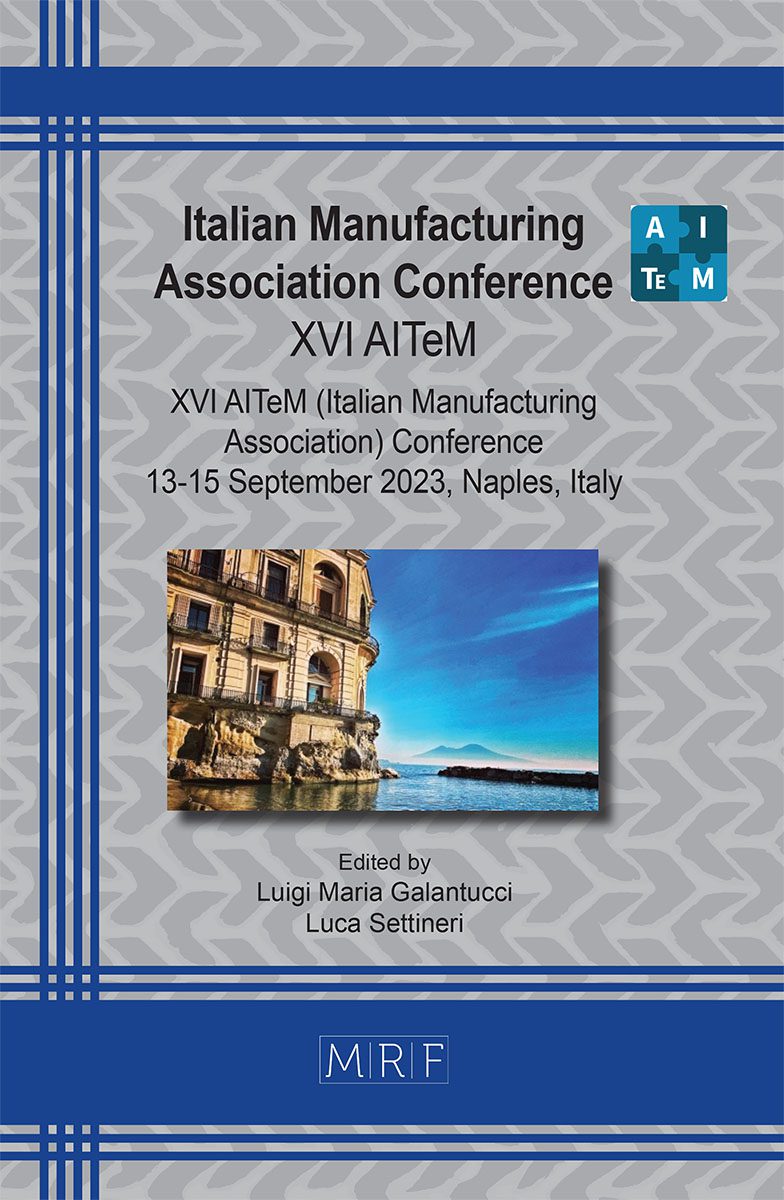Manufacturing of a hybrid component in Ti6Al4V-ELI alloy by combining diffusion bonding and superplastic forming
Pasquale Guglielmi, Antonio Piccininni, Angela Cusanno, Gianfranco Palumbo
download PDFAbstract. Through Diffusion Bonding (DB) large surfaces can be joined with low distortions and localized microstructural changes. Heterogeneous Titanium (Ti) components, composed, for example, by a porous layer over a bulk one, which play a key role for biomedical applications, can be obtained. In the present work, the possibility to combine the SuperPlastic Forming (SPF) process (for creating the part’s shape) and the DB process (for joining two different layers) is investigated. In particular, the porous layer was obtained by solid state foaming, made possible thanks to a heat treatment set on a slice cut from a billet produced by compacting Ti powders via Hot Isostatic Pressing (HIP). SPF was used to shape both the Ti sheet and the slice cut from the HIPed billet. Since the SPF is conducted at high temperature, a porous structure could be obtained in the HIPed material (solid state foaming occurred); setting the proper pressure and time, the two layers could be successfully joined by DB. All the investigated pressure levels revealed to be able to produce a complete solid state joint, without any discontinuity; in addition, the final hybrid component could be manufactured according to the desired geometry.
Keywords
Bonding, Sheet Forming, Titanium Alloys
Published online 9/5/2023, 8 pages
Copyright © 2023 by the author(s)
Published under license by Materials Research Forum LLC., Millersville PA, USA
Citation: Pasquale Guglielmi, Antonio Piccininni, Angela Cusanno, Gianfranco Palumbo, Manufacturing of a hybrid component in Ti6Al4V-ELI alloy by combining diffusion bonding and superplastic forming, Materials Research Proceedings, Vol. 35, pp 37-44, 2023
DOI: https://doi.org/10.21741/9781644902714-5
The article was published as article 5 of the book Italian Manufacturing Association Conference
![]() Content from this work may be used under the terms of the Creative Commons Attribution 3.0 license. Any further distribution of this work must maintain attribution to the author(s) and the title of the work, journal citation and DOI.
Content from this work may be used under the terms of the Creative Commons Attribution 3.0 license. Any further distribution of this work must maintain attribution to the author(s) and the title of the work, journal citation and DOI.
References
[1] B. Hamilton, S. Oppenheimer, D.C. Dunand, D. Lewis, Diffusion Bonding of Ti-6Al-4V Sheet with Ti-6Al-4V Foam for Biomedical Implant Applications, Metall. Mater. Trans. B. 44 (2013) 1554–1559. https://doi.org/10.1007/s11663-013-9942-5
[2] B. Derby, E.R. Wallach, Theoretical model for diffusion bonding, Met. Sci. 16 (1982) 49–56. https://doi.org/10.1179/030634582790427028
[3] O.D. Sherby, J. Wadsworth, Superplasticity-Recent advances and future directions, 1989. https://doi.org/10.1016/0079-6425(89)90004-2
[4] Y.H. Kim, J.M. Lee, S.S. Hong, Optimal design of superplastic forming processes, J. Mater. Process. Technol. 112 (2001) 166–173. https://doi.org/10.1016/S0924-0136(00)00880-3
[5] W. Han, K. Zhang, G. Wang, Superplastic forming and diffusion bonding for honeycomb structure of Ti-6Al-4V alloy, J. Mater. Process. Technol. 183 (2007) 450–454. https://doi.org/10.1016/j.jmatprotec.2006.10.041
[6] M. Dewidar, Mechanical and Microstructure Properies of High Porosity Sintered Ti- 6Al- 4V Powder for Biomedical Applications, JES. J. Eng. Sci. 34 (2006) 1929–1940. https://doi.org/10.21608/jesaun.2006.111343
[7] F.X. Zimmerman, Hot isostatic pressing: today and tomorrow, J. Mater. Sci. Technol. 1 (2008) 1–11.
[8] A.T. Sidambe, Biocompatibility of advanced manufactured titanium implants-A review, Materials (Basel). 7 (2014) 8168–8188. https://doi.org/10.3390/ma7128168
[9] M. Sarraf, E. Rezvani Ghomi, S. Alipour, S. Ramakrishna, N. Liana Sukiman, A state-of-the-art review of the fabrication and characteristics of titanium and its alloys for biomedical applications, Bio-Design Manuf. 5 (2022) 371–395. https://doi.org/10.1007/s42242-021-00170-3
[10] F. Li, J. Li, H. Kou, L. Zhou, Porous Ti6Al4V alloys with enhanced normalized fatigue strength for biomedical applications, Mater. Sci. Eng. C. 60 (2016) 485–488. https://doi.org/10.1016/j.msec.2015.11.074
[11] P. Guglielmi, A. Piccininni, A. Cusanno, A.A. Kaya, G. Palumbo, Mechanical and microstructural evaluation of solid-state foamed Ti6Al4V-ELI alloy, Procedia CIRP. 110 (2022) 105–110. https://doi.org/10.1016/j.procir.2022.06.021
[12] H.S. Lee, J.H. Yoon, C.H. Park, Y.G. Ko, D.H. Shin, C.S. Lee, A study on diffusion bonding of superplastic Ti-6Al-4V ELI grade, J. Mater. Process. Technol. 187–188 (2007) 526–529. https://doi.org/10.1016/j.jmatprotec.2006.11.215
[13] D. Sorgente, G. Palumbo, A. Piccininni, P. Guglielmi, L. Tricarico, Modelling the superplastic behaviour of the Ti6Al4V-ELI by means of a numerical/experimental approach, Int. J. Adv. Manuf. Technol. 90 (2017) 1–10. https://doi.org/10.1007/s00170-016-9235-7































